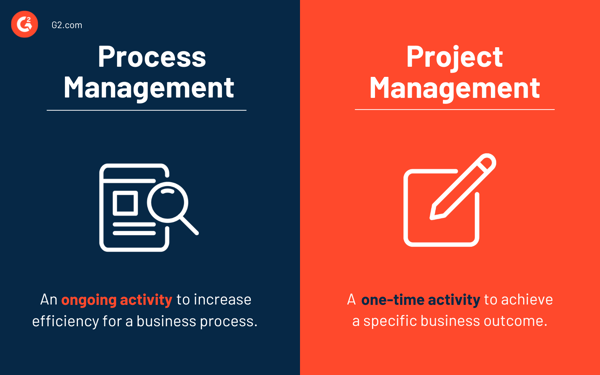February 20, 2023
 by Dinesh Varadharajan / February 20, 2023
by Dinesh Varadharajan / February 20, 2023

Growth doesn’t happen without change.
Businesses operating with outdated processes can't keep up with the dynamic and competitive marketplace. Unmanaged processes create chaos in multiple ways, including waste of resources, time, and talent.
Individuals working on different levels of a business model often fail to see processes as a whole. But by practicing business process management, organizations can tackle inefficiency and improve their daily operations.
Business process management (BPM) is the practice of analyzing and improving business processes. It’s an ongoing activity that identifies areas of improvement and makes changes to the existing strategy by reducing bottlenecks, automating manual tasks, and improving overall efficiency.
Companies operating with business process management software often apply process mining to gain insights into existing processes and workflows. This visibility allows supervisors to identify process vulnerabilities and fix them with data-driven solutions.
BPM is not a one-dimensional practice or technology. It comprises several layers of actions concerned with studying, identifying, and tweaking processes to ensure daily operations run smoothly and can be improved over time.
Processes are everywhere. All routine business activities in your company happen as processes. When you start taking processes seriously, they become tools that help you achieve your business goals.
Process management positively impacts multiple teams and employees. The underlying benefit of BPM is that it enhances organizational efficiency. Work happens quickly, leading to a faster journey toward improving your business.
For example, when an employee onboarding process is made efficient, there are three positive impacts on the organization.
BPM works in multiple forms; some processes can be completely automated, while others need human input to make decisions. So every organization needs all three types of BPM in different quantities.
In a document-centric process, the entire process is built with a document at its core. The goal of the process is to send the document through different stages in an approval workflow and get it authorized. Document-centric BPM reduces the need for emailing documents back and forth. You can prevent losing the document in the content drive, among many other files.
A budget approval process is document-centric BPM. The initiator fills out a form with all details about the budget request and sends it to the next person in the workflow. The approval process is assigned to the designated authority based on the amount requested, items in the budget, or any other condition.
In a human-centric process, most of the heavy lifting is done by humans. Humans decide what happens after each step in the process. The automation of steps is limited here.
A human-centric BPM system is designed to be human-friendly. It has a visual interface to help employees understand the process and manage it easily. You should focus on human-centric processes since they directly impact employees and customers.
The best example of a human-centric process is the hiring process in your company. A team lead realizes the need for an extra employee and requests one from her manager. The manager reviews the request and passes it on to the HR department. An HR executive posts the job opening and starts screening candidates based on a selection criteria.
In an integration-centric process, the focus is on creating a smooth data flow between a network of software. It is mainly centered around the integration of different software systems. An automated and integrated set of tools means less manual work and higher productivity.
The most common example of an integration-centric process is the connected system of tools used by marketing and sales. Selling a product effectively needs a highly connected and informed marketing and sales department.
A marketing campaign is started through a marketing tool, the source of leads is tracked in an analytics tool and stored in a customer relationship management (CRM) software with detailed information on the lead's journey. The sales team uses this information to engage leads and turn them into customers.
As mentioned above, BPM has a sequence of steps that make up a cycle. Here are the five main stages in a BPM lifecycle.
Projects are focused on achieving one-time goals. An app development project involving a lot of collaboration and spontaneous decisions is an excellent example of project management.
On the other hand, BPM aims to improve processes that are always active and happening in an organization. For example, a purchase order approval process.

There is one similarity between projects and processes. Both are broken down into individual tasks. Each task is assigned to teams or individual employees. Here are the key differences between a project and a process:
| Attribute | BPM | Project management |
| Purpose | An ongoing activity that focuses on increasing efficiency | A one-time event to achieve a specific outcome |
| Execution | Happens in a cycle | Has a starting and ending point |
| Management | Designated process managers or department heads who own the process | Designated project managers that change with each project |
| Nature | Has a lot of repetitive tasks that happen as a routine | Has a lot of tasks that need human attention and unique resolutions |
| Course of improvement | Monitored and optimized at regular intervals after a few cycles | Improved on the go with small experiments and iterations |
While projects help you achieve particular outcomes, BPM is a company-wide practice that focuses on continuously improving existing processes that define the core of your business.
There are countless benefits that result from good BPM practice. Here are some of the primary benefits.
When organizations strictly follow documented processes, everyone is clear on their goals. Employees are informed of their responsibilities and know what to do. This fixates on fail-fast and learn-fast work culture.
An organization that is flexible to changes can easily sail through all difficult times. Flexibility allows room for experiments and eventually leads to an agile organization.
Since processes are meticulously planned and constructed in BPM, every task is quick and error-free. Employees don't need to rely on their superiors to tell them what to do. The process clearly states their responsibilities, increasing the productivity of every employee involved.
Errors don't occur often. Even if they do, they are easy to track to a particular step in the workflow. Once they are fixed, measures will be taken to ensure the same error does not happen again.
Data security is becoming a bigger concern for IT leaders. Employees need to access data from different sources to get work done. BPM also prevents accidental data access issues. Let’s say an employee requests a certain view in a software tool.
IT is responsible for showing only the data that a particular job role has clearance to access and not more. While designing a process, you define data clearance for each step and job role. BPM acts as a security measure to ensure employees access only what they need.
Digital transformation is one of the primary goals for IT leaders. It is about leveraging technology to enhance the experiences of employees and customers. BPM fits this definition perfectly.
Processes always focus on both employees and customers. Since BPM aims to make processes efficient, you automatically undergo digital transformation. A more focused approach to digital transformation is through a no-code BPM platform. Business users can create simple workflow-based applications on their own without IT help.
BPM is an easy approach to complying with all agreements. Since BPM works on rules and conditions, you create the process in compliance with your internal and external policy agreements. The process runs on these rules making compliance a necessity.
Process monitoring is a part of the BPM lifecycle. You can keep tabs on all processes and be notified if any items are close to a policy breach.
is the compound annual growth rate (CAGR) for the business process management market, projected to value at $26.18 billion by 2028.
Source: Fortune Business Insights
Business processes differ per region and company size, making managing them difficult. Leaders must be aware of such challenges to address them spontaneously.
When putting together a BPM strategy, poor leadership can affect the entire process. Simply buying expensive BPM software is not enough to implement a great strategy. Leaders must have the vision to know how to use these resources best.
Moreover, some leaders fail to monitor daily operations after implementing process changes. BPM is not a one-time approach; it's an ongoing activity. So, continuous monitoring is needed if you want to survive unprecedented disruptions.
Operating in a fast-paced environment can sometimes lead to business owners losing control of processes. And a business not in control of its operations can’t succeed.
When workflows are disorganized, implementing a BPM strategy can be tricky. It can result in disruption of daily operations, which can, in turn, lead to losing customers, waste of resources, and employee dissatisfaction.
Each business process must have a goal right from the start with clearly defined KPIs to ensure a smooth operational flow. Moreover, these KPIs and goals must be shared across the board to maintain consistency in the workflow.
When goals and KPIs are clearly communicated, businesses will know what to optimize to enhance overall organizational efficiency.
Change in processes or workflows can sometimes lead to resistance from employees, especially the ones unfamiliar with technology. Business leaders are responsible for effectively communicating the reasons behind process changes.
For example, instead of feeling threatened by automated processes, employees should recognize how to make their jobs easier and outcomes efficient with automation.
For BPM to succeed in automating your workflow and transforming your operations, keep the following best practices in mind.
One of the most common mistakes businesses make is implementing all the changes simultaneously. It's important to prioritize and measure the outcomes of small changes before making any drastic transformations. So, if you need to revert to older methods, it wouldn't require much effort.
Going digital is no longer a choice but a necessity. Digital processes are executed faster and eliminate human error. It also supports a more satisfactory customer experience and increases employee collaboration opportunities.
Once you have digitized your manual processes, the next step to enhance efficiency is to automate repetitive tasks. Automation will not only save time by speeding up your processes but also save resources by reducing the occurrence of mistakes.
Your clients have the best perspective when it comes to your business operations. Don’t implement changes blindly. Talk to customers and identify the problems they are facing. Then, come up with solutions to make things better.
Here's a practical and actionable guide to implementing BPM on a small level and measuring optimal results.
Pick one crucial business process that you’ve been struggling with. To experience the best results, choose a process that happens in large volumes. Once you select the process, start the analysis.
Collect detailed information on the number of transactions, cycle time, time taken to complete each step, most common errors, shadow tasks, and skill levels of employees involved in the process. By the end of your analysis, arrive at a list of things to be fixed to streamline the process.
As a rule of thumb, all processes should be focused on achieving a specific goal. The goal should be clearly defined and measurable. Create modes of measurement by setting appropriate KPIs.
For example, your goal may be delivering a better employee experience. Multiple touchpoints determine employee experience. It starts with candidate screening, onboarding, training, service requests, and any other department-specific process. Each of these processes has KPIs that can indicate the efficiency of the process.
Once the goals are set, choose a BPM tool with the right set of features that fit your needs. A dedicated process management tool keeps all processes in one place. Instead of tracking them in multiple tools and emails, you can make changes to the process and measure results easily.
Now you know both the errors and goals of the process. Bridge the gap by redesigning the process.
Here are some pointers to keep in mind while redesigning the process:
Before you go ahead and squeeze in an entirely new process, get buy-in from the stakeholders and upper management. Most BPM efforts fail due to a lack of employee buy-in. When an employee is required to shift from their comfort zone, you should give them a compelling reason.
Explain to them what errors will be prevented and how their work will get easier. When the stakeholders invest their efforts in your new process, it is much easier to implement it successfully.
The next step is actually to implement the process. Do it in small progressive steps that are easy to control. Wait until people adjust and adapt to the new methods. Also, tweak the new process during implementation if required.
A process is made efficient by constant monitoring and optimization. You need to be able to measure the KPIs in order to keep a close eye on the performance of a process. Processes don’t need active scrutinizing, but they need a thorough analysis at regular intervals.
A BPM tool has reporting and analytics capabilities that give detailed insights into each process you build in the tool. It provides immediate notifications when items are close to SLA breaches.
The most crucial step is to take action and modify the process based on the generated reports instead of letting them sit in the corner.
Processes are essential for an organization. They determine how quickly and smoothly you reach your business goals. But business process management is more than just a practice. It is a company-wide culture that is developed over time once implemented. BPM encourages businesses to take a goal-oriented approach toward their daily operations.
Start small with one process and implement a solid BPM approach to improve it. Once that is set up and running well, go to the next process. Continue doing that, and by the end of pulling in all processes into BPM, you are now running an efficient and agile business.
Take your organizational efficiency to the next level by automating end-to-end processes with digital process automation (DPA) software.
This article was originally published in 2020. It has been updated with new information and examples.
Dinesh Varadharajan is the Chief Product Officer at Kissflow and leads the product management team. He is a hands-on executive with a wide range of experience working with bleeding-edge technologies, developing great products, and mentoring highly productive teams. He was recently named one of the Top 100 Great People Managers 2020 by Great Manager Institute & Forbes India.
Every business leader wants to boost productivity and lower costs. Automation tools can help,...
 by Daniel Corin Stig
by Daniel Corin Stig
It’s well known that marketing and creative teams are constantly under pressure to produce...
 by Julia Schonrock
by Julia Schonrock
Many SaaS companies provide business process automation, but finding the right place for it...
 by Vladimir Ivanchenko
by Vladimir Ivanchenko
Every business leader wants to boost productivity and lower costs. Automation tools can help,...
 by Daniel Corin Stig
by Daniel Corin Stig
It’s well known that marketing and creative teams are constantly under pressure to produce...
 by Julia Schonrock
by Julia Schonrock


